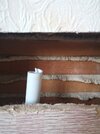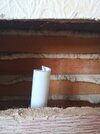Hello everyone. This has probably been discussed previously but have not found any informative posts making me feel a bit better. (panic) So as many other fellow DIYers, I have purchased a nice Victorian terraced house built in the 1920s.The big renovations have started today and boy is the project full of surprises. The main bedroom is seperated by, what it seems, a plasterboarded wall. This does not look like a recent build as the plasterboards is extremely crumbly. Having cut into this wall, I have found that little fibers stick out of the plaster material, so immediate panic stepped in as suspected to be asbestos. Could any way more experienced people let me know what you think? Upon researching I came across the fact that hair was added to Lime plaster back in the day for strength. So I am currently very conflicted.
Ordered an asbestos test kit but wanted to see if anyone had an idea here first.
Best regards.
George
Ordered an asbestos test kit but wanted to see if anyone had an idea here first.
Best regards.
George




